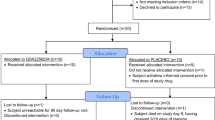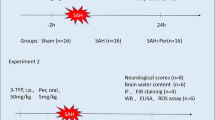Abstract
Background
Patients recovering from aneurysmal subarachnoid hemorrhage (SAH) are at risk for developing delayed cerebral ischemia (DCI). Experimental and human studies implicate the vasoconstrictor P450 eicosanoid 20-hydroxyeicosatetraenoic acid (20-HETE) in the pathogenesis of DCI. To date, no studies have evaluated the role of vasodilator epoxyeicosatrienoic acids (EETs) in DCI.
Methods
Using mass spectrometry, we measured P450 eicosanoids in cerebrospinal fluid (CSF) from 34 SAH patients from 1 to 14 days after admission. CSF eicosanoid levels were compared in patients who experienced DCI versus those who did not. We then studied the effect of EETs in a model of SAH using mice lacking the enzyme soluble epoxide hydrolase (sEH), which catabolizes EETs into their inactive diol. To assess changes in vessel morphology and cortical perfusion in the mouse brain, we used optical microangiography, a non-invasive coherence-based imaging technique.
Results
Along with increases in 20-HETE, we found that CSF levels of 14,15-EET were elevated in SAH patients compared to control CSF, and levels were significantly higher in patients who experienced DCI compared to those who did not. Mice lacking sEH had elevated 14,15-EET and were protected from the delayed decrease in microvascular cortical perfusion after SAH, compared to wild type mice.
Conclusions
Our findings suggest that P450 eicosanoids play an important role in the pathogenesis of DCI. While 20-HETE may contribute to the development of DCI, 14,15-EET may afford protection against DCI. Strategies to enhance 14,15-EET, including sEH inhibition, should be considered as part of a comprehensive approach to prevent DCI.







Similar content being viewed by others
References
le Roux AA, Wallace MC. Outcome and cost of aneurysmal subarachnoid hemorrhage. Neurosurg Clin N Am. 2010;21:235–46.
Dorhout Mees SM, Kerr RS, Rinkel GJ, Algra A, Molyneux AJ. Occurrence and impact of delayed cerebral ischemia after coiling and after clipping in the International Subarachnoid Aneurysm Trial (ISAT). J Neurol. 2012;259:679–83.
Dorsch N. A clinical review of cerebral vasospasm and delayed ischaemia following aneurysm rupture. Acta Neurochir Suppl. 2011;110:5–6.
Brathwaite S, Macdonald RL. Current management of delayed cerebral ischemia: update from results of recent clinical trials. Transl Stroke Res. 2013;5:207–26.
Dankbaar JW, de Rooij NK, Velthuis BK, Frijns CJ, Rinkel GJ, van der Schaaf IC. Diagnosing delayed cerebral ischemia with different CT modalities in patients with subarachnoid hemorrhage with clinical deterioration. Stroke. 2009;40:3493–8.
You J, Johnson TD, Marrelli SP, Bryan RM Jr. Functional heterogeneity of endothelial P2 purinoceptors in the cerebrovascular tree of the rat. Am J Physiol. 1999;277:H893–900.
Pluta RM, Hansen-Schwartz J, Dreier J, et al. Cerebral vasospasm following subarachnoid hemorrhage: time for a new world of thought. Neurol Res. 2009;31:151–8.
Macdonald RL. Delayed neurological deterioration after subarachnoid haemorrhage. Nat Rev Neurol. 2014;10:44–58.
Iliff JJ, Jia J, Nelson J, Goyagi T, Klaus J, Alkayed NJ. Epoxyeicosanoid signaling in CNS function and disease. Prostaglandins Other Lipid Mediat. 2010;91:68–84.
Poloyac SM, Reynolds RB, Yonas H, Kerr ME. Identification and quantification of the hydroxyeicosatetraenoic acids, 20-HETE and 12-HETE, in the cerebrospinal fluid after subarachnoid hemorrhage. J Neurosci Methods. 2005;144:257–63.
Cambj-Sapunar L, Yu M, Harder DR, Roman RJ. Contribution of 5-hydroxytryptamine1B receptors and 20-hydroxyeiscosatetraenoic acid to fall in cerebral blood flow after subarachnoid hemorrhage. Stroke. 2003;34:1269–75.
Dietrich HH, Horiuchi T, Xiang C, Hongo K, Falck JR, Dacey RG Jr. Mechanism of ATP-induced local and conducted vasomotor responses in isolated rat cerebral penetrating arterioles. J Vasc Res. 2009;46:253–64.
Zhang W, Koerner IP, Noppens R, et al. Soluble epoxide hydrolase: a novel therapeutic target in stroke. J Cereb Blood Flow Metab. 2007;27:1931–40.
Node K, Huo Y, Ruan X, et al. Anti-inflammatory properties of cytochrome P450 epoxygenase-derived eicosanoids. Science. 1999;285:1276–9.
Nation DA, Edland SD, Bondi MW, et al. Pulse pressure is associated with Alzheimer biomarkers in cognitively normal older adults. Neurology. 2013;81:2024–7.
Iliff JJ, Fairbanks SL, Balkowiec A, Alkayed NJ. Epoxyeicosatrienoic acids are endogenous regulators of vasoactive neuropeptide release from trigeminal ganglion neurons. J Neurochem. 2010;115:1530–42.
Zhang W, Otsuka T, Sugo N, et al. Soluble epoxide hydrolase gene deletion is protective against experimental cerebral ischemia. Stroke. 2008;39:2073–8.
McGirt MJ, Lynch JR, Parra A, et al. Simvastatin increases endothelial nitric oxide synthase and ameliorates cerebral vasospasm resulting from subarachnoid hemorrhage. Stroke. 2002;33:2950–6.
Sozen T, Tsuchiyama R, Hasegawa Y, et al. Role of interleukin-1beta in early brain injury after subarachnoid hemorrhage in mice. Stroke. 2009;40:2519–25.
Sugawara T, Ayer R, Jadhav V, Zhang JH. A new grading system evaluating bleeding scale in filament perforation subarachnoid hemorrhage rat model. J Neurosci Methods. 2008;167:327–34.
Wang RK, Jacques SL, Ma Z, Hurst S, Hanson SR, Gruber A. Three dimensional optical angiography. Opt Express. 2007;15:4083–97.
Zhang W, Iliff JJ, Campbell CJ, Wang RK, Hurn PD, Alkayed NJ. Role of soluble epoxide hydrolase in the sex-specific vascular response to cerebral ischemia. J Cereb Blood Flow Metab. 2009;29:1475–81.
An L, Qin J, Wang RK. Ultrahigh sensitive optical microangiography for in vivo imaging of microcirculations within human skin tissue beds. Opt Express. 2010;18:8220–8.
Abramoff MD, Magalhaes PJ, Ram SJ. Image processing with ImageJ. Biophotonics Int. 2004;11:36–42.
Jouihan SA, Zuloaga KL, Zhang W, et al. Role of soluble epoxide hydrolase in exacerbation of stroke by streptozotocin-induced type 1 diabetes mellitus. J Cereb Blood Flow Metab. 2013;33(10):1650–6.
Reilly C, Amidei C, Tolentino J, Jahromi BS, Macdonald RL. Clot volume and clearance rate as independent predictors of vasospasm after aneurysmal subarachnoid hemorrhage. J Neurosurg. 2004;101:255–61.
Crago EA, Thampatty BP, Sherwood PR, et al. Cerebrospinal fluid 20-HETE is associated with delayed cerebral ischemia and poor outcomes after aneurysmal subarachnoid hemorrhage. Stroke. 2011;42:1872–7.
Barden AE, Croft KD, Beilin LJ, Phillips M, Ledowski T, Puddey IB. Acute effects of red wine on cytochrome P450 eicosanoids and blood pressure in men. J Hypertens. 2013;31:2195–202 discussion 202.
Pradilla G, Chaichana KL, Hoang S, Huang J, Tamargo RJ. Inflammation and cerebral vasospasm after subarachnoid hemorrhage. Neurosurg Clin N Am. 2010;21:365–79.
Alkayed NJ, Goyagi T, Joh HD, et al. Neuroprotection and P450 2C11 upregulation after experimental transient ischemic attack. Stroke. 2002;33:1677–84.
Kawasaki T, Marumo T, Shirakami K, et al. Increase of 20-HETE synthase after brain ischemia in rats revealed by PET study with 11C-labeled 20-HETE synthase-specific inhibitor. J Cereb Blood Flow Metab. 2012;32:1737–46.
Martini R, Ward J, Siler D, et al. Genetic variation in soluble epoxide hydrolase is associated with outcome after aneurysmal subarachnoid hemorrhage. J Neurosurg 2014 (in press).
Sehba FA, Hou J, Pluta RM, Zhang JH. The importance of early brain injury after subarachnoid hemorrhage. Prog Neurobiol. 2012;97:14–37.
Fu C, Yu W, Sun L, Li D, Zhao C. Early cerebral infarction following aneurysmal subarachnoid hemorrhage: frequency, risk factors, patterns, and prognosis. Curr Neurovasc Res. 2013;10:316–24.
de Rooij NK, Greving JP, Rinkel GJE, Frijns CJM. Early prediction of delayed cerebral ischemia after subarachnoid hemorrhage: development and validation of a practical risk chart. Stroke. 2013;44:1288–94.
Rabinstein AA, Weigand S, Atkinson JL, Wijdicks EF. Patterns of cerebral infarction in aneurysmal subarachnoid hemorrhage. Stroke. 2005;36:992–7.
Shimoda M, Takeuchi M, Tominaga J, Oda S, Kumasaka A, Tsugane R. Asymptomatic versus symptomatic infarcts from vasospasm in patients with subarachnoid hemorrhage: serial magnetic resonance imaging. Neurosurgery. 2001;49:1341–8 discussion 8-50.
Etminan N, Vergouwen MD, Ilodigwe D, Macdonald RL. Effect of pharmaceutical treatment on vasospasm, delayed cerebral ischemia, and clinical outcome in patients with aneurysmal subarachnoid hemorrhage: a systematic review and meta-analysis. J Cereb Blood Flow Metab. 2011;31:1443–51.
Sabri M, Ai J, Lakovic K, D’Abbondanza J, Ilodigwe D, Macdonald RL. Mechanisms of microthrombi formation after experimental subarachnoid hemorrhage. Neuroscience. 2012;224:26–37.
Deng Y, Edin ML, Theken KN, et al. Endothelial CYP epoxygenase overexpression and soluble epoxide hydrolase disruption attenuate acute vascular inflammatory responses in mice. FASEB J. 2011;25:703–13.
Iliff JJ, Alkayed NJ. Soluble epoxide hydrolase inhibition: targeting multiple mechanisms of ischemic brain injury with a single agent. Future Neurol. 2009;4:179–99.
Ostergaard L, Aamand R, Karabegovic S, et al. The role of the microcirculation in delayed cerebral ischemia and chronic degenerative changes after subarachnoid hemorrhage. J Cereb Blood Flow Metab. 2013;33:1825–37.
Koerner IP, Jacks R, DeBarber AE, et al. Polymorphisms in the human soluble epoxide hydrolase gene EPHX2 linked to neuronal survival after ischemic injury. J Neurosci. 2007;27:4642–9.
Liu M, Alkayed NJ. Hypoxic preconditioning and tolerance via hypoxia inducible factor (HIF) 1alpha-linked induction of P450 2C11 epoxygenase in astrocytes. J Cereb Blood Flow Metab. 2005;25:939–48.
Acknowledgments
We thank Joseph Quinn for generously supplying cerebrospinal fluid samples from the Oregon Alzheimer Center, NIA—AG0801, UL1TR000128. We thank Dennis Koop, Lisa Bleyle, and the Bioanalytical Shared Resource/Pharmacokinetics Core facility for their expertise in eicosanoid analysis. We thank Mary Heinricher for help with statistical analysis and manuscript composition. Dominic A. Siler—NHLBI F30 HL108624, Oregon Brain Institute; Nabil J. Alkayed—NINDS R01 NS044313 and NS070837; Ruikang K. Wang—NHLBI R01 HL093140. NIBIB R01 EB009682; Justin S. Cetas—Brain Aneurysm Foundation; Valerie C. Anderson—NIA K25 AG033638.
Conflict of interest
Dominic A. Siler, Ross Martini, Jonathan Ward, Jonathan Nelson, Rohan Borkar, Kristen Zuloaga, Jesse Liu Jeffrey Raskin, Stacy Fairbanks, Valerie Anderson, Aclan Dogan, Ruikang K. Wang, Nabil J. Alkayed, Justin S. Cetas declare that they have no conflict of interest
Author information
Authors and Affiliations
Corresponding author
Electronic supplementary material
Below is the link to the electronic supplementary material.
12028_2014_11_MOESM1_ESM.eps
Supplementary material 1 (EPS 1470 kb). Supplemental Fig. 1: Eicosanoid levels following SAH. Concentration of A) 15-HETE, B) 12-HETE, C) 11-HETE, D) 11,12-EET and E.) 8,9-EET in picograms per milliliter of CSF in an age-/sex-matched control group (Ctrl n = 10) and in SAH patients (n = 34) up to fourteen days following SAH. nd = not detected (EPS 875 kb)
Rights and permissions
About this article
Cite this article
Siler, D.A., Martini, R.P., Ward, J.P. et al. Protective Role of P450 Epoxyeicosanoids in Subarachnoid Hemorrhage. Neurocrit Care 22, 306–319 (2015). https://doi.org/10.1007/s12028-014-0011-y
Published:
Issue Date:
DOI: https://doi.org/10.1007/s12028-014-0011-y




